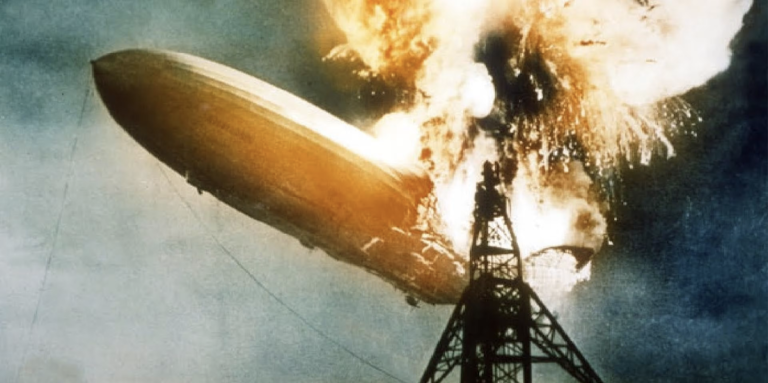
German airship erupts in flames during New Jersey docking attempt; tragedy shocks the world and halts hydrogen-powered passenger travel.
New York, N.Y. – On May 6, 1937, the hydrogen-filled German airship Hindenburg erupted in flames during its attempt to dock at the Naval Air Station Lakehurst in New Jersey, killing 36 individuals and marking a catastrophic end to the golden age of passenger airships. The disaster, witnessed by journalists and spectators, became an enduring symbol of technological vulnerability and reshaped the future of aviation.

The Final Flight
The Hindenburg, a Zeppelin-class airship operated by Deutsche Zeppelin-Reederei, had completed 63 successful transatlantic flights before its final voyage from Frankfurt to Lakehurst.
Measuring 804 feet in length, it was the largest aircraft ever built, a marvel of engineering designed to showcase Germany’s industrial prowess.
Onboard were 36 passengers and 61 crew members, many unaware of the risks posed by its flammable hydrogen lifting gas—a substitute for non-flammable helium, which the U.S. had banned from export to Nazi Germany.
Delayed by storms, the airship circled Lakehurst for hours before initiating its docking maneuver at 7:25 p.m. Witnesses reported a faint glow near the tail moments before flames engulfed the structure.
The inferno consumed the airship in 34 seconds, leaving a smoldering skeleton.
Chaos at Lakehurst
Radio broadcaster Herbert Morrison’s anguished cry, “Oh, the humanity!” captured the horror of the event, later immortalized in newsreels. Survivors leapt from windows or crawled through collapsing frames, while ground crew members risked their lives to pull others from the wreckage. Of the 97 aboard, 35 passengers and crew perished, alongside one ground worker. Dozens suffered severe burns.
Investigators later hypothesized that a static spark ignited leaking hydrogen, though debates about sabotage or engine malfunctions persisted. The U.S. Commerce Department’s report emphasized the dangers of hydrogen, concluding that the airship’s design prioritized luxury over safety.Aftermath and Investigation

The disaster shattered public confidence in airships.
Germany halted commercial Zeppelin operations, while the U.S. accelerated investments in fixed-wing aircraft.
Luftschiffbau Zeppelin, the airship’s manufacturer, shifted focus to military contracts ahead of World War II.
Survivors’ accounts and forensic analyses underscored systemic risks, including the use of hydrogen and flammable doping chemicals on the outer skin.
Critics argued that political tensions between the U.S. and Nazi Germany had indirectly contributed to the tragedy by restricting helium access.
Legacy of the Hindenburg
The Hindenburg disaster remains a cultural touchstone, symbolizing the perils of technological hubris. Documentaries, books, and memorials at Lakehurst preserve its memory, while engineers cite it as a cautionary tale in aerospace safety. Modern airship projects, such as hybrid helium models, continue to grapple with balancing innovation and risk.

#HindenburgDisaster #AviationHistory
Tags: Hindenburg, airship disasters, aviation safety, Nazi Germany, historical tragedies
Social Media Blurbs:
X (Twitter):
Headline: Hindenburg Disaster Marks End of Airship Era, 36 Lives Lost
Blurb: 86 years ago, the Hindenburg’s fiery crash changed aviation forever. #History #AviationDisaster [bit.ly/Hindenburg1937]
Bluesky:
Headline: Hindenburg Disaster Marks End of Airship Era, 36 Lives Lost
Blurb: On May 6, 1937, the Hindenburg airship tragedy shocked the world. Explore its lasting impact on travel and safety. #AviationHistory #TechFail [bit.ly/Hindenburg1937]
LinkedIn:
Headline: Hindenburg Disaster Marks End of Airship Era, 36 Lives Lost
Blurb: The 1937 Hindenburg disaster offers critical lessons in risk management and technological innovation. How can industries balance progress with safety today? This tragedy reshaped aviation, underscoring the need for adaptive engineering and international collaboration. #Leadership #RiskManagement #AviationHistory
Full article: https://www.stewardshipreport.org/hindenburg-disaster-1937
Truth Social:
Headline: Hindenburg Disaster Marks End of Airship Era, 36 Lives Lost
Blurb: May 6, 1937: Hydrogen-filled airship crashes in NJ, killing 36. A pivotal moment in aviation history. #HistoricalEvents https://www.stewardshipreport.org/hindenburg-disaster-1937
Mastodon:
Headline: Hindenburg Disaster Marks End of Airship Era, 36 Lives Lost
Blurb: Communities worldwide remember the Hindenburg disaster, a tragedy that united survivors and reshaped global travel. How do we honor its lessons today? Explore the full story and share reflections. #HistoryMatters https://www.stewardshipreport.org/hindenburg-disaster-1937
Instagram:
Headline: Hindenburg Disaster Marks End of Airship Era, 36 Lives Lost
Blurb: Witness the fiery moment that changed aviation history. Swipe up to read about the Hindenburg’s legacy.
#History #Aviation #Disaster #TechHistory #NeverForget
Link in bio.
Facebook:
Headline: Hindenburg Disaster Marks End of Airship Era, 36 Lives Lost
Blurb: 86 years ago, the skies over New Jersey turned to chaos as the Hindenburg airship burst into flames. Discover the untold stories of survival, the science behind the disaster, and its lasting impact on how we travel. #AviationHistory #HistoricalTragedy
Full article: https://www.stewardshipreport.org/hindenburg-disaster-1937
Reddit:
Headline: Hindenburg Disaster Marks End of Airship Era, 36 Lives Lost
Blurb: The Hindenburg disaster is often blamed on hydrogen, but could it have been prevented with better U.S.-Germany relations or helium access? How does this tragedy inform modern engineering ethics? #AskHistorians https://www.stewardshipreport.org/hindenburg-disaster-1937